| |
|

FRIDAY, JUNE 20 Temple Solel Freilich Friday
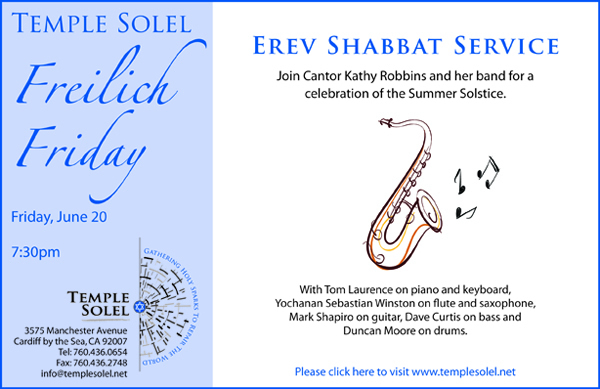

Friday, July 11 Congregation Beth El Kabbalat Shabbat Services


Jews are Obama’s base, not his problem
By J. Zel Lurie
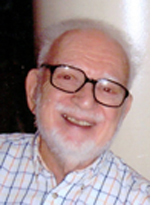 DELRAY BEACH, Florida—Democratic presidential candidate Barack Obama quickly backtracked from his statement at the AIPAC conference that Jerusalem “must remain undivided” which angered Palestinians and Israeli peaceniks, but was almost unnoticed by the thousands of conference delegAtes. DELRAY BEACH, Florida—Democratic presidential candidate Barack Obama quickly backtracked from his statement at the AIPAC conference that Jerusalem “must remain undivided” which angered Palestinians and Israeli peaceniks, but was almost unnoticed by the thousands of conference delegAtes.
As reported in last week’s Journal the loudest applause came when Obama spoke of Jewish unity with Blacks in the struggle for civil rights in the South. The overwhelming Jewish vote for Obama in November will bring back those halycon days.
The tiny minority of right-wing Jewish Republicans like Mort Klein and Americans for Safe Israel continue to make noise about Obama’s former pastor. An American Jewish Committee survey in 2006 found that only 15 percent of American Jews were registered Republican.
Senator Joseph Lieberman, who was the Democrat’s candidate for Vice-President in 2000, descended to their level by repeating lies about Obama’s background in a speech for John McCain last week. Obama berated him on the Senate floor the following day and Liebeman made a half-ass apology.
Within 24 hours of his AIPAC speech, Obama had learned the realities of West JeruSalem, the capital of Israel, and East Jerusalem, which the Palestinians want for their capital, He told CNN:
“Obviously it’s going to be up to the parties to negotiate a range of issues and Jerusalem will be part of these negotiations.”
Obama added that he’d like to see Jerusalem remain a united city but it’s hardly practical.
It’s not practical because Jerusalem since 1948 has never been a united city. In reuniting East and West Jerusalem in 1967 and removing the wall which had separated the two since 1948, Moshe Dayan and Teddy Kollek tripled the area of East Jerusalem by adding 22 West Bank agricultural villages which morphed into urban Arab slums as their farm land and recreational forests were expropriated to build large Jewish residential neighborhoods such as Pisgat Zeev and Har Homa.
East Jerusalem now contains about a quarter million Palestinian Arabs, who are not citizens of Israel but receive all its benefits, and about an equal number of Jewish citizens.
And the little wall that was knocked down in 1967 has been replaced by a large wall of concrete blocks that separates East Jerusalem Arabs from West Bank Arabs.
Barack Obama’s statement on Jerusalem was featured in the Hebrew and Arabic press. A Kuwait newspaper called it “a slap in the face.” Uri Avneri, the octogenerian founder of Gush Shalom, published an essay titled “No We can’t.”
Gush Shalom placed an ad in Ha’aretz of June 5 which rhymes in Hebrew. It began:
Every child in Israel
Knows by now that
There will be no peace
Without dividing Jerusalem
The New York Times did a disservice to its readers on May 22, the day that Obama was scheduled to talk at the B’nai Israel congregation in Boca Raton, Florida. It featured a story headed “Many Florida Jews Express Doubts on Obama.”
In the lead to the story “many Florida Jews” turned out to be a conversation about Obama’s problems by two octogenarian women. The loudest yenta intended to vote for McCain but her friend was a silent supporter of Obama.
Reading beyond the lead, I learned that Obama had garnered 45 percent of the Jewish voters in the primaries, excluding Florida. I never would have guessed it since I was firmly in Hillary’s camp.
Further into the story I found a quote from Rabbi David Saperstein of the Religious Action Center of Reform Judaism who delineated Obama’s appeal to Jews:
“There is Obama the scholar, the social justice advocate, the defender of Israel with a close feel for Jewish concerns garnered through decades of intimate friendships.”
The Times reporter, Jodi Kantor, who was not responsible for the headline of the story, described Obama’s Jewish friendships.
“Throughout his career,” Kantor related, “Obama has enjoyed close ties with Jews, including various employers, a few school buddies, wealthy donors on the north side of Chicago who backed his early political career, and the many Jews in the Hyde Park community where he lives. This may account for some of his apparent incredulity” at the attacks on him by Jews.
In my opinion Obama has little to fear from the lies that Jewish Republicans are sending on the internet. George W. Bush captured 22 percent of the Jewish vote in the last presidential election. John McCain will be lucky to do as well..
My breakfast club of 170 retired Jews who, by a slim majority, voted against me when I opposed invading Iraq five years ago, last week voted overwhelmingly for Obama.
It is fair to say, as the Forward did recently, “The Jews are Obama’s base not his problem.”
Remembering Tommy Lapid
I’d like to conclude with a word about a fellow journalist and a good friend who died recently in Jerusalem of cancer at 76.
Yosef Tommy Lapid was born Tomislav Lempel in 1931 to Hungarian parents who lived in Yugoslavia. His father, a lawyer and journalist, was killed in a Nazi extermination camp. Tommy survived with his mother in the Budapest ghetto.
Tommy arrived in Israel with his mother in 1948. For many decades he was one of Israel’s top journalists and popular TV personality. In 1999 he entered politics. He formed the party of Change to take up the cudgels against the religious parties, notorious for feeding on the public treasury and for their ever expanding draft exemptions.
Four years later, his party was the second largest in Ariel Sharon’s government. But he lost the bitterly fought 2005 budget battle. Sharon allocated $65 million to the religious parties, which are now stronger than ever.
Sharon brought in Labor to replace Change in his cabinet. Tommy left politics and his party disintegrated. He ended his days as the chairman of Yad Veshem.
His son, Yair Lapid, has continued the family tradition. He is a leading TV host.
By Rabbi Simcha Weinstein
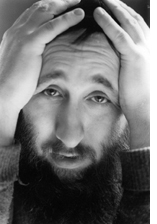 NEW YORK—It's been almost exactly five years since director Ang Lee's big budget movie The Hulk roared intotheaters. Fans and critics alike were less than impressed, so moviegoers eagerly anticipated the release of director LouisLeterrier's new half-remake/half-revamp of the Bruce Banner saga, called The Incredible Hulk. NEW YORK—It's been almost exactly five years since director Ang Lee's big budget movie The Hulk roared intotheaters. Fans and critics alike were less than impressed, so moviegoers eagerly anticipated the release of director LouisLeterrier's new half-remake/half-revamp of the Bruce Banner saga, called The Incredible Hulk.
The basic story of the Hulk has become a staple of popular culture, thanks to the long running comic book and blockbuster 1970s TV series: a gamma ray accident saddles scientist Dr. Bruce Banner with a violent, unshakable alter ego. Known as the Hulk, this strapping, spinach-colored powerhouse has little patience for compound verbs (or much else), and has apparently been wearing the same pair of torn yet strangely intact blue trousers for more than forty years. This time around, the Hulk is played by Oscar-nominated actor Edward Norton (Fight Club, American History X).
 As an involuntary superhero, the Hulk archetype originally served as a stark warning against the dangers of scientific experimentation, and as a thinly veiled metaphor for the volatile social climate of the early sixties. When the Hulk made his comic book debut, the United States and the Soviet Union were still locked in the Cold War, one in which physical casualties were few, but the emotional fallout was palpable. Anxiety about an imminent atomic attack colored everyday life. As an involuntary superhero, the Hulk archetype originally served as a stark warning against the dangers of scientific experimentation, and as a thinly veiled metaphor for the volatile social climate of the early sixties. When the Hulk made his comic book debut, the United States and the Soviet Union were still locked in the Cold War, one in which physical casualties were few, but the emotional fallout was palpable. Anxiety about an imminent atomic attack colored everyday life.
The Hulk was created by two Jewish comic book legends, Stan Lee and Jack Kirby, so it is particularly poignant that a symbolic parallel can be made with the Jewish state of Israel. Israel has enriched the world in countless ways, making numerous breakthroughs in medical research and technology. Sadly, all too often these contributions to humanity are overlooked, and its enemies view Israel as the world’s pariah.
Likewise, Bruce Banner is pursued by the American military, the very same men who'd once employed him. Led by the stern General Ross, they devote their entire arsenal to killing the Hulk.
Ross’s daughter Betty has feelings for Banner, but Banner's tragic, secret double life renders him unable to return her affection. In the new movie, Banner is closer than ever to finding a cure for his affliction, but he has his (big green) hands full: while being pursued by another monster called The
Abomination, the lonely, loveless Hulk is called upon to save New York City from destruction.
Just as the Jewish people were forced to wander from place to place to survive, so too the misbegotten Hulk wanders the planet in an elusive search for sanctuary.
A Jewish version of the Hulk can be found in the Golem, Judaism's own monster-hero. While many comic book superheroes bear a superficial resemblance to the Golem, the Hulk truly personifies this mythical being; he is a powerful if extremely unpredictable protector, the result of an experiment gone horribly wrong. As Stan Lee once remarked, “When you think about it, the Incredible Hulk is a Golem.”
Like other superheroes, Hulk's strength recalls that of the biblical Samson. The series contains more
obviousreferences to Samson as well. A character named Doctor Leonard Samson, a psychiatrist who believes he can cure the Hulk, appears in #141 (1971). The nerdy Doctor Samson empowers himself through a controlled dose of radiation and becomes Doc Samson, a massively muscled, green-haired superhuman with gamma-boosted strength, sporting long hair like his biblical namesake.
Cutting Doc Samson's hair saps his power, too. In #227 (1978), Samson proposes therapy
for the Hulk (a particularly Jewish remedy?) and even constructs a steel-reinforced psychiatrist's couch! And in #373 (1990), Samson's Jewish roots are confirmed when he admits he attended "Yeshiva" and that he was intimidated by “a very strict rabbi.”
Over the course of the comic book series, as the Hulk roams the world in search of meaning and acceptance, it seems inevitable that he would eventually reach the place that people throughout history have made pilgrimages to: the holy land of Israel. In the 1981 issue #256 entitled "Power and Peril in the Promised Land", theHulk does just that, aboard a freighter called Star of David.
Rudely awakened when the ship docks in Tel Aviv, Banner turns into the Hulk. Little does he realize he’s about to meet another superhero: his exact opposite in appearance, but one
who shares the Hulk’s “anger issues.”
Patrolling the dock at this time is a young dark-haired, feisty Israeli policewoman with a secret.
"The military are in no shape to go after the Hulk!" she declares. "That leaves me to stop the
monster before he menaces the rest of Tel Aviv!"
At that, the policewoman transforms into "Sabra, super heroine of the state of Israel." Sabra's costume, like the Israeli flag, is blue and white, emblazoned with a Star of David.
"Sabra" is the word used to describe a Jew born in the Land of Israel. The word is derived from the
Hebrew, tzabar, the "prickly pear" cactus, Opuntia ficus-indica. Rough to the touch, this desert plant has a sweet interior. Israelis may sometimes seem "prickly”but this is simply a natural defense mechanism. Israel is a kind and benevolent nation at heart.
But the Incredible Hulk himself is the ultimate sabra: he is angry on the outside, but inside he yearns to
use hispowers for peace. Representing all the oppressed minorities who are feared because they look or act different. From the original comic books to his latest cinematic incarnation, the Hulk is a classic archetype whose appeal spans generations, because his circumstances speak to us all.

Nancy Harrison
cruise & tour specialist
(619) 265-0808

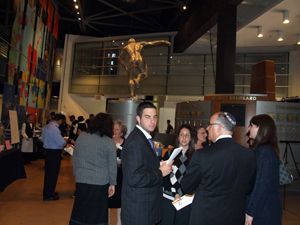 
THE JEWISH CITIZEN
Orthodoxy and sports juxtaposed at gala
By Donald H. Harrison
 SAN DIEGO—It was an evening of juxtapositions Sunday, June 15, making me think that perhaps the Maccabees and the Hellenists, if only for a night, had called a truce some 2,000 years after the great Chanukah war. The entryway to the Hall of Champions in Balboa Park is dominated by a large statue of an Olympic discus thrower, dressed as the athletes of ancient Greece normally were attired—in the nude. SAN DIEGO—It was an evening of juxtapositions Sunday, June 15, making me think that perhaps the Maccabees and the Hellenists, if only for a night, had called a truce some 2,000 years after the great Chanukah war. The entryway to the Hall of Champions in Balboa Park is dominated by a large statue of an Olympic discus thrower, dressed as the athletes of ancient Greece normally were attired—in the nude.
Mingling in conversation beneath the large statue were Orthodox men in kippot and women wearing sheidels. A big difference from the Chanukah story was that the observant Jews had come to the sports temple, not vice versa, and instead of desecrating it, they filled it with kosher foods and prayers.
Another memorable juxtaposition came during a mincha service when men davened together in a vestibule alongside the named jerseys of some of football’s greatest players including former San Diego Chargers Dan Fouts and Rolf Benirschke. It was almost as if the followers of our monotheistic religion—whose forbearers were told never to worship idols—somehow had persuaded modern day sports idols to worship the true God with them.
The occasion was the gala marking the 45th anniversary of Soille San Diego Hebrew Day School, with auctions of three varieties— silent, Chinese, and live bidding— all helping the school to raise its $850,000 goal for its coming fiscal year. The live auction for large Jewish-themed framed pictures executed by each of the classes from kindergarten through eighth grade, under the skillful auctioneering of Dr. Duvy Kupferberg, a former president of Congregation Adat Yeshurun, was a spirited affair, with some of the pupils’ creations earning hundreds of dollars for the school and some thousands of dollars.
Jews are no strangers to sports especially here in the United States, where we boast of various athletes—among them boxers, baseball players, football players, and swimmers—who have made us proud. What Jewish child in public school has not been told of Los Angeles Dodger pitcher Sandy Koufax who declined to pitch during the World Series on Yom Kippur (If he can do that, Sheldon, you can miss a Little League game!). And who does not remember Mark Spitz coming home from the Olympics with so many gold medals around his neck, some doctors were worried he might dislocate something.
Teenage Jewish athletes compete every summer in the JCC Maccabi games, with San Diego serving as the host city this year from August 3 to 8.
The Hall of Champions is filled with images and memorabilia of top-notch athletes who have something to do with San Diego—either being raised here but playing somewhere else, such as the legendary Ted Williams of the Boston Red Sox, or perhaps being raised somewhere else like Los Angeles but playing on a team here, such as the incomparable Tony Gwynn of the San Diego Padres. There are some notable Jewish athletes among those here honored, among them Sid Gillman and Ron Mix who respectively coached and played for the San Diego Chargers during the team’s early history when it was in the separate American Football League.
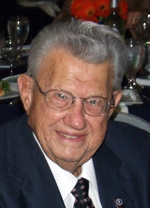 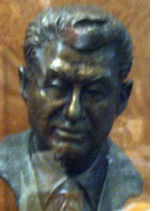 The founder of the museum is also Jewish, Bob Breitbard, a former high school athletics coach—and he was at the Hebrew Day School celebration both in the flesh and in the form of a bronze bust fashioned years ago in his honor and located near the entryway. The founder of the museum is also Jewish, Bob Breitbard, a former high school athletics coach—and he was at the Hebrew Day School celebration both in the flesh and in the form of a bronze bust fashioned years ago in his honor and located near the entryway.
Several other linkages between the world of sports and Hebrew Day School became apparent during the evening. Dr. Karl Jacobs, who last July 9 became the 134th person to swim the 21-mile Catalina Channel (between Catalina Island and the California mainland), covering the distance in 10 hours, 7 minutes and 58 seconds, unveiled a display board about his feat that will be exhibited permanently in the museum.
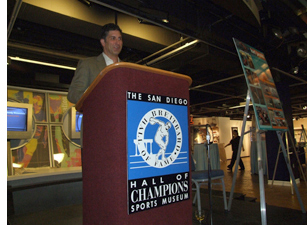 Jacobs (pictured with display board at right) said that his swim seemed a metaphor for life itself: “While day to day we think we’re making hard decisions all alone, in truth we are supported by our community,” he said. About long distance swimming, he said, “you can’t do it without family, friends and community.” Jacobs (pictured with display board at right) said that his swim seemed a metaphor for life itself: “While day to day we think we’re making hard decisions all alone, in truth we are supported by our community,” he said. About long distance swimming, he said, “you can’t do it without family, friends and community.”
Predictably some of the auction items were sports-related: for example, a “take me out to the ballgame” package which offered the successful bidder an opportunity to “wow your favorite baseball fan with a ball autographed by future Hall of Famer Albert Pujols (of the St. Louis Cardinals), plus get a little local action with 4 tickets to see any remaining Padres game of the season. Look like a fan with an authentic Padres hat and shirt!” The value on this package was stated to be $625. Another bid item, for teens, included passes to the Solid Rock Gym, Parkway Bowl, and some amusement park venues. For smaller children, private swimming lessons with John Tarney were offered.
In the Chinese Auction, in which people drop raffle tickets into designated boxes, one offering was “After School Fun with Ms. Christina Dawson.” Besides being the PE teacher at Soille San Diego Hebrew Day School, Dawson is a certified taekwondo master. The package offered after school ball playing plus a taekwondo class.
The event coincided with the U.S. Open being played in San Diego, and at my table Dr. Ricky Wolf told how he was able to have the best of both worlds as a spectator—both following the golfers around the course and having a seat in the gallery waiting for them to come to him. He said he got there early enough to make a deal to get a seat overlooking the pin on the 18th green. There he set up lawn chairs, and made a deal with people sitting near him that if they would save his seats while he wandered, he would do the same for them when they wanted to follow the action. One of the most exciting moments he said was watching the foursome including Tiger Woods approaching the 18th green. Behind Woods was an army of spectators, looking like the approaching legions shown in the great epic movies like The Ten Commandments or Ben-Hur.
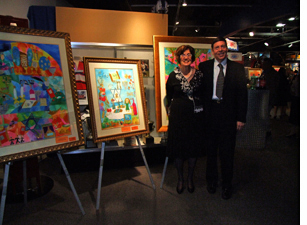 Wolf, a member of Congregation Beth Israel, to honor Susan Weiner, a member of his chavurah, who was retiring as a secular fifth grade teacher after 25 years at Soille San Diego Hebrew Day School. Also at the table was Ethel Adatto, a former principal of the school, who had hired Weiner. The veteran teacher is pictured at left with her husband Ed by some of the art works created by Soille fifth grade students. Wolf, a member of Congregation Beth Israel, to honor Susan Weiner, a member of his chavurah, who was retiring as a secular fifth grade teacher after 25 years at Soille San Diego Hebrew Day School. Also at the table was Ethel Adatto, a former principal of the school, who had hired Weiner. The veteran teacher is pictured at left with her husband Ed by some of the art works created by Soille fifth grade students.
In formal comments and in an interview, Weiner said that teaching is “an avocation, not a vocation” and “if you don’t love it, don’t do it.” A video, featuring comments from students, indicated how loved they had felt under Weiner’s tutelage.
Having taught in the public schools of St. Louis, Mo., and Alexandria, Va., Weiner said that she soon realized that in order for students at the Hebrew Day School to study both secular and Judaic subjects in the same time that public school students devote to secular subjects alone, “I had to teach everything in half the time. I talked fast and gave them a lot of homework,” she said.
Adatto said that as soon as she had interviewed Weiner for the job in 1983, she recognized a “dedicated, excited, committed teacher—and we became best friends after I resigned from that position.” Adatto today is the principal at Torah High School.
Also honored was PTA President Deborah Brookler, whose organizational skills are put to use for celebrations or commemorations of every Jewish holiday and in planning the 8th grade trip to Israel
The Center for Initiatives in Jewish Education of the Caroline and Joseph S. Gruss Lie Monument Funds, Inc., was honored for its investment of more than $170,000 in Soille Hebrew Day School to underwrite a technology lab and learning center as well as a middle school math and science enrichment program. CIJE President Jason Cury accepted the award.
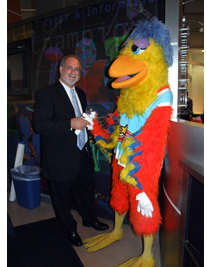 The school's headmaster, Rabbi Simcha Weiser (pictured playfully posing with a model of the San Diego Chicken) alluded to Father’s Day occurring on the same day of the gala. He told a story about a father and son who both had been offered jobs in different towns, but had only one proper jacket to wear to the work place. They decided to ask the rabbi who deserved the jacket more. Each argued his case before the rabbi, telling why he—rather than the other—should be the family bread winner. After listening, the rabbi instructed them to go home and to come back the following day and make the best arguments that they could in the other’s behalf. Father should argue for son, and vice versa. They did as they were instructed, and when they were finished, the rabbi went to his closet and pulled out an extra coat—so that both could go to work. The school's headmaster, Rabbi Simcha Weiser (pictured playfully posing with a model of the San Diego Chicken) alluded to Father’s Day occurring on the same day of the gala. He told a story about a father and son who both had been offered jobs in different towns, but had only one proper jacket to wear to the work place. They decided to ask the rabbi who deserved the jacket more. Each argued his case before the rabbi, telling why he—rather than the other—should be the family bread winner. After listening, the rabbi instructed them to go home and to come back the following day and make the best arguments that they could in the other’s behalf. Father should argue for son, and vice versa. They did as they were instructed, and when they were finished, the rabbi went to his closet and pulled out an extra coat—so that both could go to work.
They thanked the rabbi, but were puzzled. Why hadn’t he simply made that generous gesture the day before? The rabbi responded that it is unpleasant when a father and son argue, but when they speak for each other, it causes listeners to expand their hearts and think what can they also do to make the world a better place.



OBITUARY
Isadore Horne, Holocaust survivor, 92
By Donald H. Harrison
SAN DIEGO—Isadore Horne, 92, who hid in a chimney as Nazis marched his family and other townspeople to a killing field, and later was able to escape to join partisans in the forests of Poland, was eulogized Monday, June 16, in the sanctuary of his synagogue as a man who never gossiped nor said a negative word about anyone.
Horne had served for two decades on the board of the New Life Club of Holocaust Survivors, including a term as that organization’s president. Along with his wife of 63 years, Betty, whom he had discovered and nursed back to health when she was a teenager in hiding in Poland, Horne also had been active on the board of the Collwood Apartments in eastern San Diego, until eventually they moved to a retirement home in the Rancho San Diego area.
Horne’s body lay in a simple pine casket in front of the bima of Tifereth Israel Synagogue as Rabbi Leonard Rosenthal related that after Betty had regained her health, Horne told her “You have lost your family. So have I. We only have each other, so let’s get married.” She consented.
Although there was no rabbi around to officiate, Horne had been a yeshiva student prior to the war and knew that all that was required for a Jewish marriage to be solemnized was for two adult witnesses to be present. He rounded up witnesses, and other friends, and intoned the words that ‘with this ring you are consecrated to me.”
To satisfy a succession of civil authorities, however, the Hornes subsequently were remarried in civil ceremonies in Russia, Poland and Germany, and in 1994, on their 50th wedding anniversary, they did it all over again, only this time under a chuppah, with Rabbi Rosenthal officiating and a ketubah signed by the original witnesses.
The Hornes lived in Displaced Persons camps from the end of the war until 1949, and then immigrated to Philadelphia, where they stayed briefly before moving to Pittsburgh. There Horne established a glass and mirror installation business and gained a reputation as a man who would respond to an emergency at any hour of the day and still charge fair prices, Rosenthal said.
Additionally, Rosenthal reported “Izzy’s workers loved him” because when they had family emergencies he did not deduct the time away from work from their paychecks—an enlightened practice which was not at all common in the 1950s and 1960s.
Horne was active in B’nai B’rith in Pittsburgh, serving as a lodge president and later as a district president, Rosenthal reported. He gained a reputation as a humorist—a man with a joke for every occasion. Sometimes, the jokes intended for rabbis were based on Jewish sources that Horne had learned while in yeshiva. “I had to look up the sources to understand the punch lines,” Rosenthal confided.
The Horne’s retired to San Diego in 1978, and over much of the next three decades he continued lecturing about the Holocaust as he had done in Pennsylvania. At High Holiday services, Horne also was given the honor of chanting El Moley Rachamim to memorialize those like his mother, brother and sister who were murdered in the Holocaust.
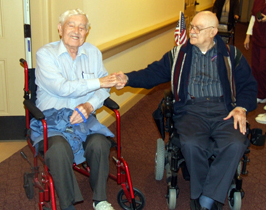 At La Vida Real in Rancho San Diego, where several Tifereth Israel families have chosen to retire, the Hornes were particularly friendly with Resa and Sy Brenner. Like Horne, Brenner could walk but required a wheel chair to travel over longer distances. At La Vida Real in Rancho San Diego, where several Tifereth Israel families have chosen to retire, the Hornes were particularly friendly with Resa and Sy Brenner. Like Horne, Brenner could walk but required a wheel chair to travel over longer distances.
The two, pictured at left with Horne on the left and Brenner on the right, had much to talk about—Brenner had been captured by the Germans as an American prisoner of war, and spent his incarceration in terror that his Nazi captors would discover that he was Jewish.
Rosenthal commented that Horne never lost his sense of humor. When my wife Nancy and I saw him last March, he and Brenner were engaged in a “can you top this one” kind of contest at the dinner table.
"Resa and I had dinner and lunch every day with Izzie and Betty," Brenner commented following the funeral. "He was a refined gentleman. He was a gentle man who had a very good sense of humor and was well liked by everyone."
Horne, born January 3, 1916, died this last Shabbat morning, June 14, with his wife Betty holding his hand, Rabbi Rosenthal said. His surviving children includee a son Hal and daughter Sherry, both of whom reside in Southern California
Following the synagogue service, Horne’s body was transported to Greenwood Memorial Park in San Diego for burial.


ADVENTURES IN SAN DIEGO JEWISH HISTORY
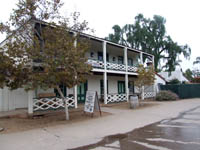
Robinson-Rose House
|
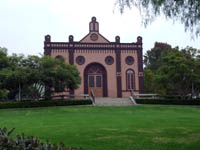
Old Temple Beth Israel |
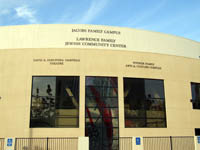
Lawrence Family JCC |
Editor's Note: We are reprinting news articles that appeared in back issues of various San Diego Jewish newspapers. You may access an index of the headlines of those articles by clicking here. You may also use the Google search program on our home page or on the headline index page to search for keywords or names.
Pioneer Women
From Southwestern Jewish Press, March 20, 1947, page 4
It is gratifying to report that as a result of our successful Purim Dance, we were enabled to send a substantial check promptly complying with an urgent request received from Dvorah Rothbard of the National office. She has left for Palestine this week to attend a special session at Jerusalem and with her went an unprecedented amount of money from Pioneer women of America so that Moatzoath Hapoaloth can carry on at this crucial time.
With plans already made for a Donors’ Dinner to be held on August 10th, at which time our 10th anniversary will also be celebrated, we feel certain our quote for Moatzoath Hapoaloth will be met. This of course does not include our Child Rescue Fund Quota, the chairman for which is Mrs. Clara Resnick. We know what a zealous worker she is and that this quota will also be met through her engineering of child rescue fund raising.
During the month of April, our plans are to co-operate with the Jewish welfare Fund drive so that the women’s division can meet its quota.
Our Chavera Conway is taking a vacation at Gilman’s Hot Springs and we wish her a pleasant vacation and complete recovery from her recent illness.
Appeal for Seder Home Hospitality for Servicemen
From Southwestern Jewish Press, March 20, 1947, page 4
All families in the community who are having home seders are urged to invite servicemen as their guests.
Up to the present time, no arrangements have been made for a public seder, so it is important that all servicemen be taken care of through home hospitality.
As in the past, it is hoped that the San Diego Jewish community will respond wholeheartedly to the appeal of the JWB-Army and Navy committee for men in the service.
If you are having a seder in your home will you please contact Esther Siegel, JWB Director, Spreckles Bldg., Franklin 8805.
B’nai B’rith Presents Wheel Chairs to Hospital
From Southwestern Jewish Press, March 20, 1947, page 5
Veterans recuperating at the United States Naval Hospital will have the use of six new wheel chairs which were presented yesterday by Lasker Lodge B’nai B’rith. In a brief but impressive ceremony, David H. Block, chairman of the Americanism and Patriotic Services Committee made the presentation.
The gift is just one of the many services of this committee that worked during the war and is continuing their services and work with the American Armed Forces. During the war, the {national} Americanism and Patriotic Services Committee of the B’nai B’rith gave 2,000,000 games, books and magazines to the armed forces; furnished 67 mobile units of equipment which included station wagons, ambulances, canteens and blood donor units; and fitted more than 650 ships with recreational facilities such as athletic, music and libraries.
Carl Esenoff to Head Jewish Welfare Society
From Southwestern Jewish Press, March 20, 1947, page 5
At a meeting of the Board of Directors at the Jewish Welfare Society held in their office son Wednesday, March 12th, officers to serve for the ensuing year were elected. To serve as president will be Carl M. Esenoff with Dr. A.P. Nasatir, vice president; Rose Weinberger, secretary; and Sol Price, treasurer.
Well known as an ardent worker in many communal as well as Jewish organizations, Mr. Esenoff is a past president of Lasker Lodge B’nai B’rith and was at one time secretary of the United Jewish Fund. The treasurer for the past three years of the Jewish welfare Society, he is a member of the Board of Directors of many organizations which include the Guardians, the community Chest, the Boy Scouts of America and the Family Service Association. Mr. Esenoff is also a member of the State Board of Accountancy and is a past president of the San Diego Chapter of Certified Public Accountants. He attended school right here in San Diego, from Jefferson public school through San Diego High School and is a graduate of the University of California.
Mr. Esenoff is married and the father of a four-year-old daughter, Ronda Elaine. With the cooperation of the Board of Directors and the membership body as well, he will endeavor to carry to greater heights the work being passed on to him by the retiring president, Mrs. Rose Newman, whose work was invaluable in establishing the Jewish Welfare Society.
The Society meets quarterly, the next meeting scheduled for Thursday, April 24th.
{Return to top}


SAN DIEGO JEWISH WORLD THE WEEK IN REVIEW
|
|
